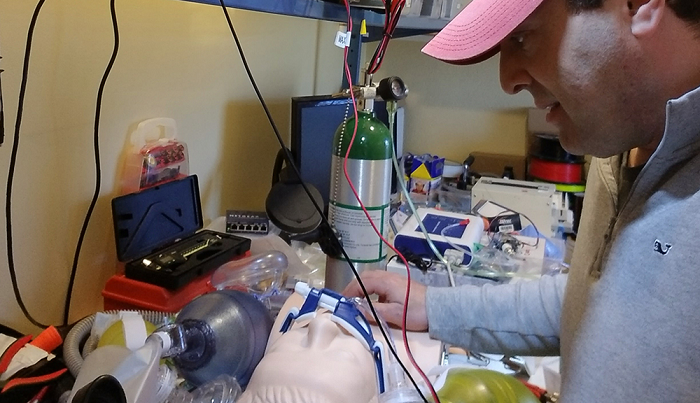By Gina Roos, editor-in-chief
Health-care providers on the frontline in the fight against the spread of the coronavirus (COVID-19) are calling out the need for more ventilators. Resident physicians at Massachusetts General Hospital (MGH) are looking for engineers, makers, and others to participate in its CoVent-19 Challenge to develop a rapidly deployable mechanical ventilator.
Researchers at Worcester Polytechnic Institute (WPI) also announced that they are developing open-source designs to speed up the creation of low-cost ventilators. Professors and students are developing multiple designs so that companies with 3D printers can manufacture the ventilators.
The U.S. has the capacity to ventilate about 170,000 patients at one time, while 960,000 patients are projected to require mechanical ventilators, according to the Society of Critical Care Medicine.
“Even with the addition of 100,000 mechanical ventilators, we may not have the capacity to ventilate all those in need, forcing physicians to make the difficult decision — who receives mechanical ventilation to continue to fight COVID-19 and who will not,” said the MGH residents.
WPI designs
WPI researchers are redesigning inexpensive and readily available manual, handheld, bag valve mask (BVM) resuscitators into automated ventilators that can fill the gap between the number of ventilators available and the much larger number that will be needed when COVID-19 peaks.
These designs don’t replicate the full-feature functionality of a commercial system and are meant for more stable patients, so the commercial ventilators with more advanced sensing and control can be used for critical patients, said researchers. These designs are expected to cost less than $500, made with readily available components, compared to $25,000 to $50,000 for a commercial ventilator. They plan to make designs of multiple devices and components publicly available so that anyone — companies or innovators — with a 3D printer and a background in electronics and mechanical engineering can produce the ventilators for their local hospitals. This includes manufacturers with the capability to scale quickly.
Using 3D printing is bringing down the costs. For example, by 3D printing the valves for the concentrator, the cost drops from about $100 to about $10 to $15, according to the researchers. In addition, the valve, invented by the researchers, is lighter and more compact and controllable than traditional valves.

Gregory Fischer, WPI’s professor of robotics engineering and mechanical engineering and director of the PracticePoint Medical Cyber-Physcial Systems R&D Center, spearheaded the WPI research work. (Image: WPI)
The idea was spearheaded by Gregory Fischer, WPI’s professor of robotics engineering and mechanical engineering and director of the PracticePoint Medical Cyber-Physcial Systems R&D Center.
“A lot of people are trying to contribute, and this is an area where we can make an impact,” Fischer said in a statement. “We’re taking things that are used every day in emergency medicine and finding a way to turn them into safe, reliable, and readily replicable ventilators that can save patients’ lives. And we’re sharing those designs with the world.”
The team, which worked remotely to develop their designs, includes Marko Popovic, assistant research professor in physics and robotics engineering; Cagdas Onal, associate professor of mechanical engineering; Dirk Albrecht, associate professor of biomedical engineering; Chris Nycz, a research scientist working with WPI’s PracticePoint; Paulo Carvalho, a robotics engineering doctoral candidate; and Hamilton White, a Ph.D. student in biomedical engineering.
CoVent-19 Challenge
The CoVent-19 Challenge is an open-innovation eight-week challenge for anyone — engineers, designers, makers, and other innovators. It was launched on the GrabCAD Challenges platform on April 1, 2020. It opens with a two-round challenge to create CAD assemblies by May 1 (Round 1: general admission) and functional prototypes by June 1 (Round 2: invitation only).
Participants can submit multiple designs during Round 1. They can submit either full system designs and/or modules/parts that can be used by other teams to integrate into their design. If you’re interested in forming or joining a team, you can submit through the Team Building or Member Search form.
Participants will have access to leaders in respiratory physiology, critical care, and ventilator technology through the medical and technical panels. They will also provide guidance to teams on the safety, clinical, and technical requirements.
Members of the winning design will also have access to resources for prototyping, safety and regulatory testing, manufacturing, and distribution through supporting partners that have experience in manufacturing medical devices.
Stratasys, a leader in 3D manufacturing and prototyping, will co-host the design process and prototyping of designs, while Ximedica, with more than 30 years of expertise in medical device design and manufacturing, will align the design with regulatory agencies to ensure compliance with national and international standards. Discussions are underway with other manufacturers, distributors, and the public sector to deliver the winning ventilator globally.
Participants will have access to GrabCAD Workbench and GrabCAD Print, which provide cloud-based tools to collaborate on draft CAD designs that can be 3D printed through Stratasys. They can also send questions to the expert panels via GrabCAD Forums. Challenge sponsors also encourage participants to work remotely using the Valispace software as a platform to collaborate on their hardware designs.
Advertisement
Learn more about Electronic Products Magazine





